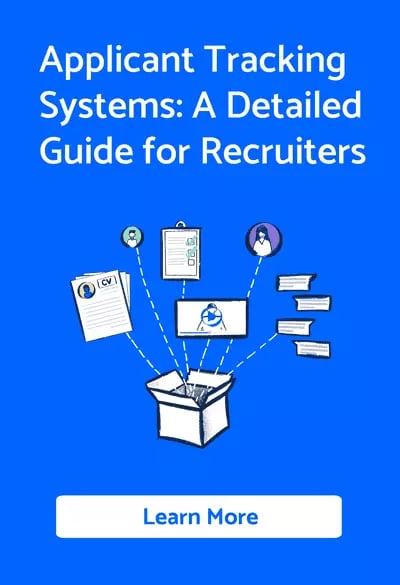Creating a compelling job advertisement is the first and the most crucial step. It sets the base for your entire recruitment campaign. If the job advertisement is catchy, you will attract qualified candidates and get great responses. But if it’s not compelling, your job advertisement will go unnoticed, wasting time and effort.
In this blog, we’ll guide you on creating a job advertisement to capture top talent’s attention and make them apply immediately. Let’s begin:
5 steps to creating a compelling job advertisement
Step 1: Understand the target audience
Creating a job ad without understanding the target audience is like shooting an arrow in the dark. You can only dream that it will hit the bulls-eye. Hence, it’s essential to research and understand your target audience before creating a job advertisement.
Here’s how it helps:
- Addressing and attracting suitable candidates: By understanding the target audience, you can create an ad that speaks directly to your ideal candidates. This way, you can attract qualified candidates and reduce the chances of receiving applications from unqualified candidates.
- Making your job advertisement appealing with the correct language: You can understand what language and terminology resonates with your target audience. Then, you can use the same language to make your job advertisement appealing.
- Highlighting the benefits: Every audience has different preferences in a job. Some are interested in salary and bonuses, while others value work-life balance or professional development opportunities. Understanding the target audience can help you understand their priorities and highlight the benefits that are the most important to them.
- Saving your time and resources: When you understand your target audience, you can create a job advertisement that addresses their requirements. You can attract a small pool of qualified candidates. This way, you must spend less time reviewing applications, conducting interviews, and interviewing new hires.
Here’s how to understand the target audience
1. Research your industry and company culture
Understanding your industry and your company’s culture is essential as it can give a more nuanced understanding of your target audience, i.e., the candidates you’re hiring. This way, you can customise your messaging and market strategies to connect with your candidates better. As a result, candidates are more likely to respond to your ads.
2. Identify your target demographic
Not everyone can be your target audience. Otherwise, you would receive applications from candidates not qualified for the position. Hence, it’s essential to understand your target demographic, i.e., the characteristics of the candidates you want to hire.
Here is some of the information a target demographic includes:
- Age
- Gender
- Ethnicity
- Geographic location
- Education level
- Occupation
- Income
- Marital Status
- Living status
By understanding the demographic of these candidates, you can define your target market and personalise your job posts to receive maximum traction from them.
Here are a few ways to identify your target demographic:
- Understand your organisation’s vision and what type of candidates can help you achieve that.
- Analyse your existing candidates, i.e., what they do, their skills, responsibilities, etc.
- Create an ideal candidate persona. It would help you understand what type of candidate you want to hire for the role.
- Analyse the type of candidates your competitors are employing. You may potentially also want to employ people with similar characteristics and skills.
3. Understand the job requirements and responsibilities
The next step is to understand the requirements and responsibilities included in the role you’re hiring. This is essential because you may not know your target audience if you don’t understand the job requirements and responsibilities. You may also not even correctly list the job requirements and duties in the job ad and attract candidates who might not be the right fit.
Step 2: Create a compelling job title
The job title is the first thing someone sees in a job advertisement. If it is not catchy or compelling, job seekers will scroll without attention, and it will vanish into oblivion like many others. Besides, a persuasive job title will:
- Make your job advert stand out from others.
- Convey the job value proposition clearly. It can help the job seeker decide whether to apply or not.
- Help candidates understand your company’s culture before applying.
- Significantly increase the quality of your ad and lead to maximum response.
Hence, it’s essential to ensure that the title of your job ad is descriptive, clear, appealing, and attention-grabbing. Here’s how you can do that:
- Make your job title stand out from other job ads. Avoid vague and generic titles that can apply to many jobs.
- Make sure the title clearly states your unique selling point. It would make your job ad stand out, and job seekers would instantly apply.
- Include the keywords your target audience would use to search for the job. It would make your ad visible to the maximum number of people.
- Make your title enjoyable with engaging and attention-grabbing language. Bland and cliché titles are a big turn-off.
- Share the title with colleagues or friends to review it. They might have suggestions for improvements that you might have missed.
Here are a few examples of catchy, clear, concise, and attention-grabbing job titles that you can use in your job ad:
- Social Media Wizard Needed
- UX/UI Jedi Wanted
- SEO Mastermind Required
- Design-thinking Expert Required
Step 3: Create an attractive job description
A compelling title is only half the job. It can attract job seekers, but they won’t apply if it doesn’t solve the purpose. Hence, it is best to create a job description that clearly describes the position you’re hiring for and is catchy enough to encourage job seekers to apply.
Here are a few tips for creating an attractive job description:
- Text that summarises the role you’re looking to fill and captures job seekers’ attention.
- Clearly list the required qualifications and skills, such as education, technical skills, soft skills, certifications, etc.
- Use short paragraphs, bullet points, and subheadings to make your job description easy to read. Also, keep the font and formatting simple to make the text visually appealing.
- Be honest about the job responsibilities, expectations, company culture, and required qualifications. Don’t overstate or overpromise, as it may backfire against you.
- Clearly emphasise unique benefits, perks, and other unique selling points in your job description. If you offer special perks like a flexible work schedule or the opportunity to work with cutting-edge technologies, ensure this is mentioned.
Overall, your job description must clearly state what the job demands and what you can offer to job seekers.
Step 4: Add more details to your job description
A clear, concise job description can get the job done but cannot compel users to hit the apply button. To ensure they apply, add a little meat, i.e., a few more details that break through resistance, answer additional queries, and convince users to apply.
Here are a few more details you can add to your job description to make it more attractive:
1. Required qualifications & skills
Do you know why an applicant tracking system rejects over 75% of job applications? It is because the required qualifications and skills are not clear. As a result, even those candidates whose skills and qualifications don’t match the requirements face rejection.
You can avoid this by adding a section mentioning the qualifications and skills you desire in a candidate. It can save you time and effort by ensuring only people whose skills and qualifications match the requirements apply.
Adding the required qualifications and skills section can also:
- Offer an indication of the candidate’s ability to perform the job.
- Reduce employee turnover as you can retain candidates with the necessary skills and qualifications for longer.
2. Salary, perks, and bonuses
Around 70% of employees want the questions of salary answered upfront. Many people have a family to feed and bills to pay. Hence, it would be best to include a section where you can clearly state the salary, bonuses, and other perks they would receive in the job. Doing so would help you in the following ways:
- Weeding out candidates who want a higher salary for the role.
- Get rid of unnecessary expectations and assure candidates that they will receive a good salary once selected for the job.
Note: Calculating an accurate salary can be challenging as it depends on many factors. You can show the salary and bonuses in round figures instead of the exact number.
3. Company culture
The most disheartening thing you can do with a candidate is to reject them because they’re not the right fit for your company’s culture. To save them from disappointment, you must include a section where you clearly describe the values and culture of your organisation. Here’s how it would help them:
- Give candidates a sense of what it’s like to work in your organisation. This way, the candidate can decide whether they fit the company right before applying.
- Filter out candidates who are not the right fit for your company. Candidates shouldn’t be chosen for a role to then leave in one month because they feel they don’t belong with you.
Here’s what you must include in the company culture and values section of your job advertisement:
- Your company’s vision and mission.
- Your company’s culture and values.
- An idea of what it’s like to work at your organisation.
Step 5: Add Visual Elements to Your Job Advertisement
Is creating a compelling job advertisement with a catchy title and a clear description enough? If you think so, you’re in for a surprise. Plain text ads are boring. Everyone’s occupied these days. They do not want to go through huge chunks of information. They might even ignore it as it can be daunting to read so much information.
Hence, it is best to spice up your job advert with catchy visuals. They make your ad stand out from the rest. Besides, adding eye-catching graphics in a job ad will help you:
- Quickly communicate your ad to job seekers and help them take action. Skimming through visual graphics is more accessible than reading large blocks of text.
- Increase engagement with your job advertisement as people are more likely to take action after looking at a visual than reading text.
- Reach a wider audience as people can easily share your ad on social media or other platforms. It increases the visibility of your advertisement.
Adding visuals in a job ad can also help you showcase your company’s culture to candidates. For example, you can put a few visuals of your office, people working from the office, or office occasions to let applicants know what it would be like to work with you should they get selected. It also helps you create a positive impression of your company and prompt more people to apply.
Conclusion
Creating a compelling job advertisement requires patience and planning. The process is time-consuming and complicated, from audience research to publishing and promoting job posts. But let’s break it down for you:
- First, you must understand your target audience, i.e., their requirements, preferences, language, or skills.
- Then, it would be best to create a captivating job description. Ensure it’s clear enough to let applicants know what’s expected from them and catchy enough to motivate them to apply.
- Once the job description is ready, you must add details like salary, perks, and company culture to your job ad. You must also clearly mention the required skills and responsibilities.
- Finally, aid your job advertisement with visuals. It is essential because visual ads capture more attention than plain text. By including graphics, you can increase traction on your job advertisement.
Also, avoid using discriminatory or biased language in your job advertisement. It must comply with all relevant laws and regulations, and the position should apply to people of all ethnicities and religions.
So, now you know what it takes to write a compelling job advertisement. Now, it’s time to implement this knowledge to create a job advertisement and share it on job boards and social sites. Also, don’t forget to capture the response and share your experience with us in the comments. We would to love to hear from you.
What are the different types of job ads?
Here are a few types of job ads and where you should place them for maximum traction:
- Traditional job ads: Companies place these ads on job boards and their website to captivate the target audience.
- Social media job ads; These are highly targeted ads on social media platforms like LinkedIn, Twitter, and Facebook.
- Referral job ads: In these ads, companies offer referral bonuses to employees referring to qualified candidates. Such job ads are distributed through employee networks.
- Niche job ads: Such job ads are targeted at specific audiences or industries.
- Passive Job ads: These job ads target candidates who might not be looking for a new job but are open to new opportunities. Such ads focus on the benefits of working for the company instead of encouraging the employee.
- Employee branding job ads: Such job ads showcase the company’s culture, values, and mission. The idea is to attract candidates who might be an excellent cultural fit for your organisation.
How to avoid formatting issues on my job advertisement?
Here are a few measures you can take to avoid formatting issues in your job ads:
- Use a clear and readable font.
- Use bullet points and subheadings to break large paragraphs into small sections.
- Keep a consistent layout throughout the job advertisement.
- Proofread and edit your job advertisement before publishing it. Spelling mistakes and typos are detrimental to your brand.






